These farmer’s cheese vareniki (aka pierogi) are soft dumplings filled with sweet farmer’s cheese. Make a huge batch and you’ll have tons to freeze for your next craving!
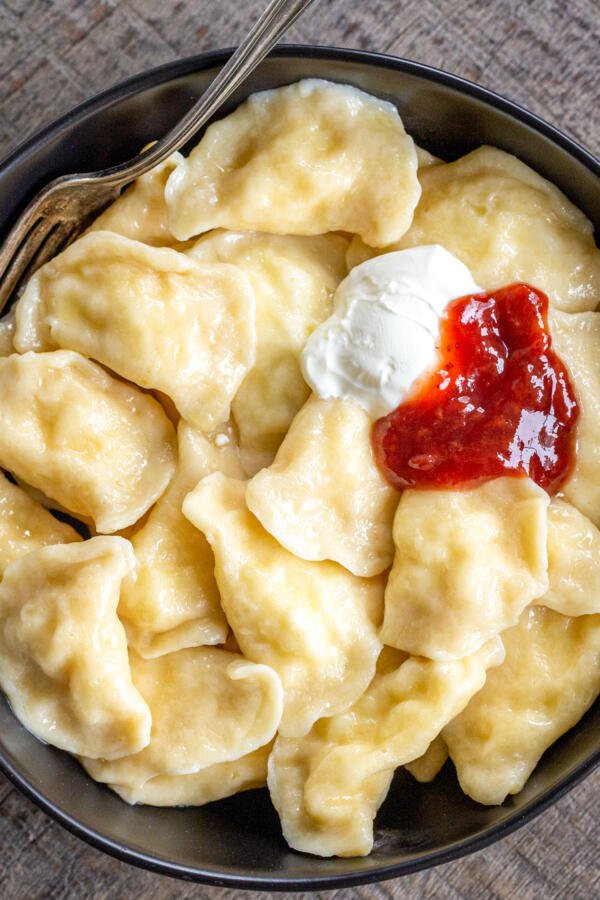
Get ready to venture straight into my childhood when you bite into pierogi with farmer’s cheese (or tvorog as we called it). Passed down through several generations, this homemade pierogi recipe is authentic, time-tested and so tasty!
Hot tip: Are you running low on time but still want vareniki/pierogi? Check out this recipe for a quick, 30 minute version of this dish.
What Are Pierogi/Vareniki?
Pierogi and vareniki are actually the same thing, but in our family, we mostly used the word vareniki. This word (or “varenyky”) is a Slavic term which means “boiled things.” In short, vareniki are dumplings filled with a range of sweet to savory fillings. Some vareniki are filled with only cheese or mashed potatoes, while others are filled with fruits (like cherries, strawberries or blueberries), vegetables, and occasionally meat. Our vareniki recipe uses a sweet filling, making it perfect for breakfast or dessert!
Vareniki Video
How To Make Vareniki
Vareniki do have a lengthier prep time than most dishes (about an hour and a half), but it’s so worth it! Set some time aside to make a large batch of vareniki, and you’ll be enjoying a freezer stash for months to come.
Make the Filling & the Dough
- Combine the liquid ingredients: In a large bowl, whisk together the eggs, sour cream, lukewarm water, and milk.
- Add in the dry ingredients: Add the all purpose flour, sugar, and salt. Knead the dough by hand or with a stand mixer until it is no longer sticky.
- Make the filling: In a separate bowl, combine the farmer’s cheese, sugar, and egg.
Hot tip: Did you know you can make your own farmer’s cheese? Check out this crazy easy way to make homemade farmer’s cheese.
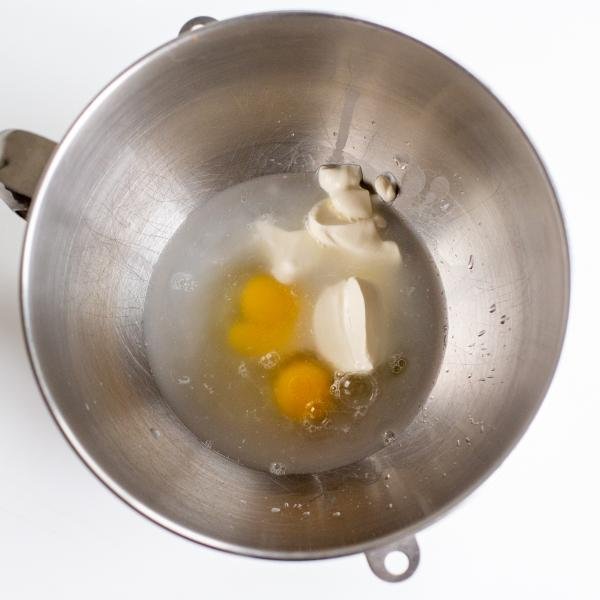
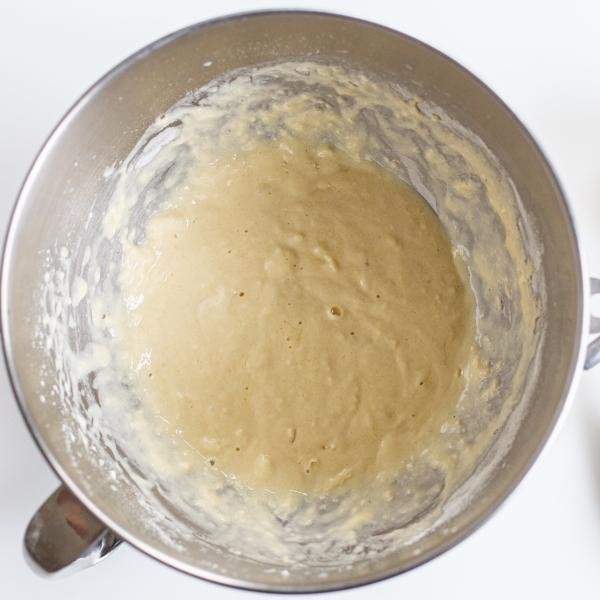
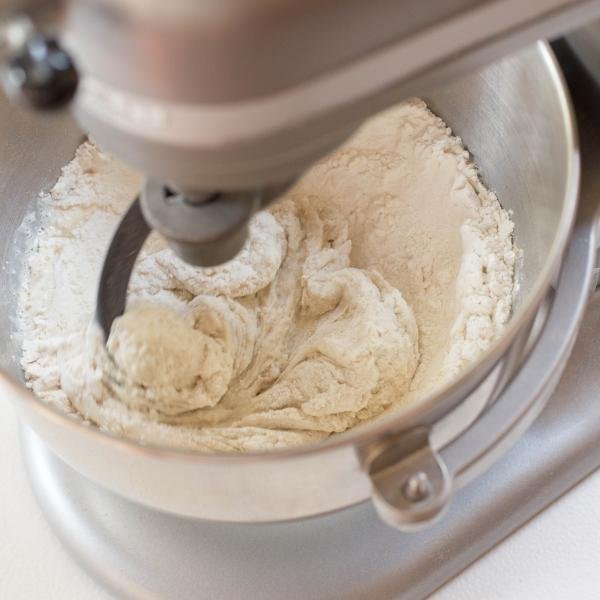
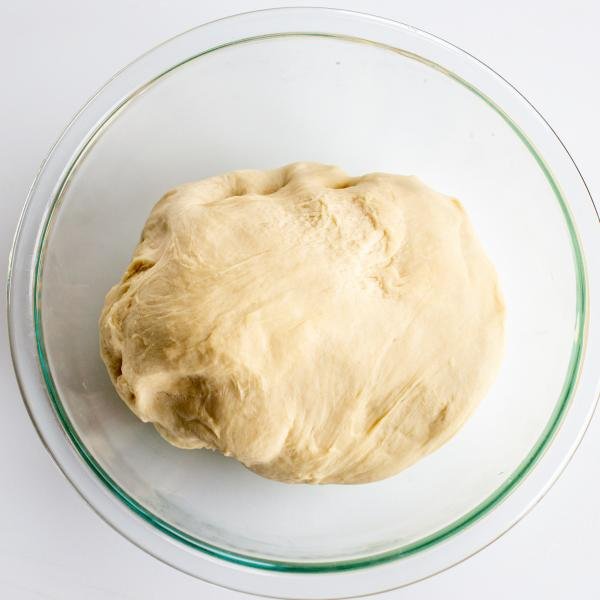
Shaping Vareniki
- Roll the dough: Roll out the dough on a well-floured surface with a rolling pin.
- Stamp out the dough circles: Using a small cup, stamp out circles in the dough.
- Add the filling: Fill the center of each dough circle with a small teaspoon of filling.
- Fold over the edges: Fold the edges of the circles over to make a half-moon shape. Push the edges together with your fingers, making sure they seal tightly so the filling doesn’t ooze out.
- Cook and serve: Bring a pot of water to a boil, then drop in 10-20 vareniki, stir, and cook until they float to the top. Once they float, drain the water from pot (or use a slotted spoon to scoop out the vareniki), add in a bit of butter and serve.
Hot tip: If you like the taste of fried or crispier vareniki, boil them first, drain, then place them on a frying pan with a bit of butter. Fry them over medium heat just until they reach a golden brown color on both sides. Yum!
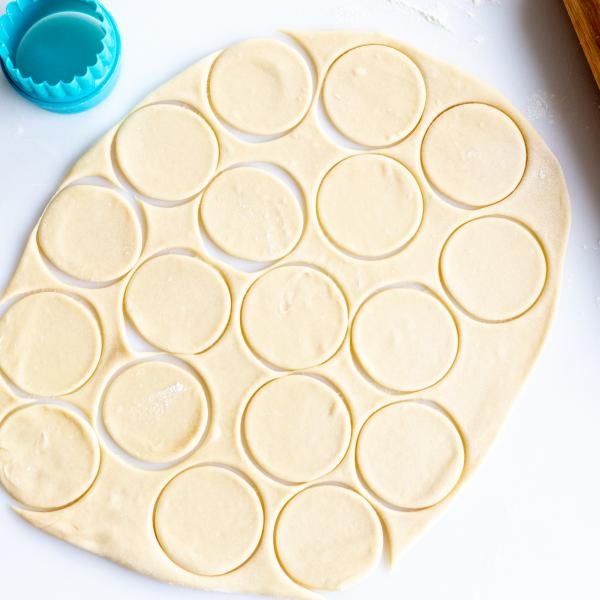

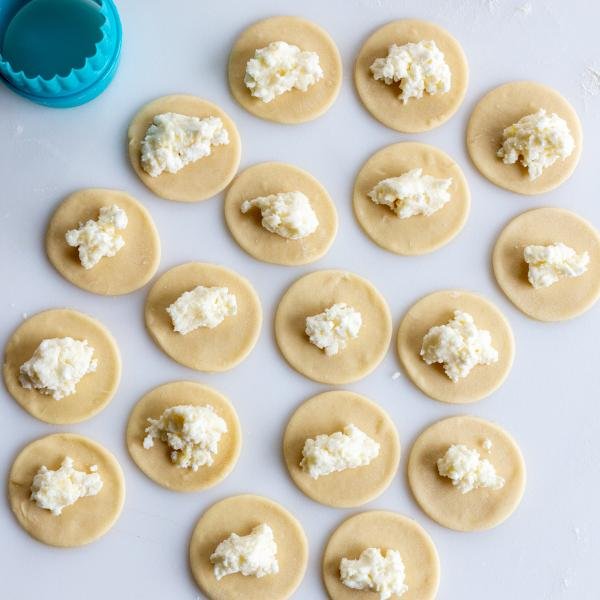
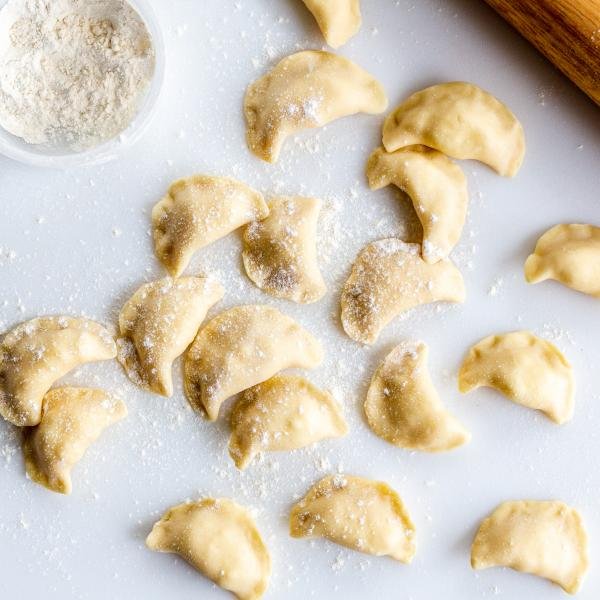
Vareniki Tips & Tricks
This easy pierogi recipe has been tested by multiple generations of our family. Over time, we’ve come up with lots of tips and tricks to make these dumplings taste and look their best. Check out these pointers to help you make the perfect batch of vareniki on your first go.
- Adjust the flour amount: For the best dough consistency, you may need to adjust the amount of flour you use. After adding the initial four cups, slowly add in more flour in ¼-½ cup amounts (if needed), kneading after each addition until the dough is soft and no longer sticky.
- Roll the dough to about three millimeters: We prefer to roll out the dough to about three millimeters in thickness, which is about the same as two stacked pennies. Avoid rolling the dough too thin, or the vareniki might rip when cooking. Make it too thick, and the outer layer of the dumplings may be too chewy.
- Change up the cutter size: If you like smaller vareniki, use a smaller cup to cut out the circles. For larger vareniki, use a larger cup. Keep in mind — the smaller the cup, the more vareniki, and the larger the cup, the less vareniki you’ll have. Depending on the size of the circles, you may find yourself with uneven amounts of dough and filling at the end.
- Use a cookie cutter: If you have a circular cookie cutter on hand, use it! It’s a perfect substitute for the cup to make the vareniki rounds.
- Flour the cup rim: Before pressing out the circles in the rolled out dough, flour the rim of the cup to make it easier to cut the circles and prevent the dough from sticking to the cup.
- Combine the “scraps”: Once you use up the rounds from the rolled-out sheet of dough, combine the “scraps” into a new ball and roll it out again. Repeat until no dough remains.
- Change up the filling: There are a ton of different pierogi filling options. Toss in small pieces of fresh fruit like berries or cherries to switch things up. For something more savory, mushroom and onion, sauerkraut and potato, or potato and cheese fillings are great options as well.
- Keep cooking until the vareniki float: Vareniki are cooked through when they begin to float at the top of the boiling water. To be extra sure, allow them to cook an extra 1-2 minutes.
Ways To Serve
Vareniki with farmer’s cheese taste amazing when freshly topped with melted unsalted butter while the dumplings are still hot. Serve them with cold sour cream, sweet fruit jam (raspberry, blackberry, strawberry) or a sprinkle of extra sugar.
Storing Cooked vs Raw Vareniki
If you cooked too many vareniki to enjoy in one go, keep reading to find the solution. Or — if you made the expert move and prepped a large batch to freeze, we’ve got the tips you’ll be needing for storing those, too!
- Cooked: Store cooked vareniki in an airtight container in the fridge for up to 2-3 days. Reheat them in a pan over medium heat with a splash of water, or place them in the microwave for a quick zap.
- Raw: Freeze raw vareniki for up to three months. First, freeze them on a floured surface like a baking sheet or cutting board. After they are completely frozen, transfer them to a freezer bag.
More Dumpling Recipes
- Steamed Blueberry Vareniki aka Pierogi — Vareniki with a sweet blueberry filling
- Classic Pierogi — Potato and cheese filled dumplings
- Meat Potato Pierogi — A yummy dinner entrée made with ground meat and mashed potatoes
- Gyoza — Japanese dumplings made with ground turkey and shredded cabbage
Recipe
Instructions
Pierogi Filling
- In a medium bowl, mix the farmer's cheese, sugar and egg until well combined. Set aside.
Pierogi Dough
- Whisk the eggs together with sour cream, lukewarm water, and milk until the mixture has an even texture.
- Add in flour, sugar, and salt to the liquid ingredients. Knead the dough by hand or with a stand mixer with dough hook attachment until it is no longer sticky.
Making Pierogi
- Roll out the dough on a well-floured surface. Using a cup or biscuit cutter, stamp out circles in the dough. Flour the cup to make it easier to cut circles.
- Fill the circles with the cheese filling, placing the filling in the center.
- Fold over the edges of the circles and pinch the edges with your fingers. Make sure the edges are tightly sealed so the filling does not fall out.
- Bring a pot of water to a boil. Add 10-20 vareniki and cook until they float to the top. Drain, then top the hot vareniki with a few small slices of butter. Optionally, serve with sour cream, jam, or sugar.
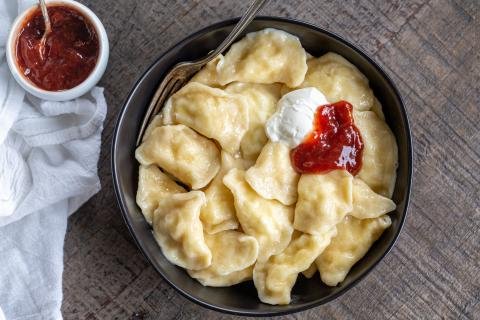
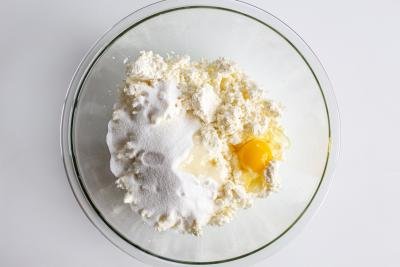
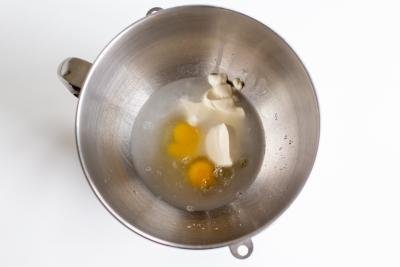
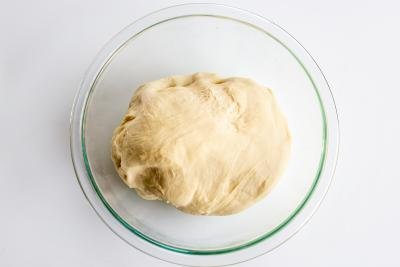
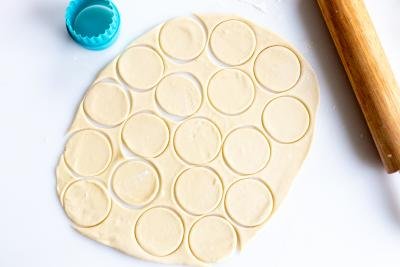
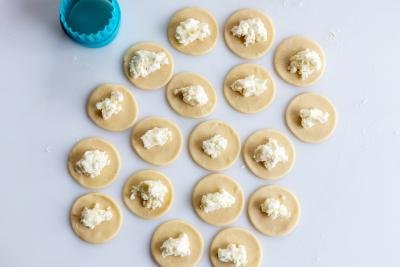
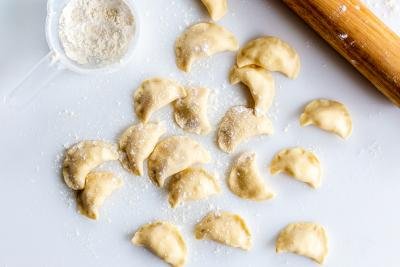
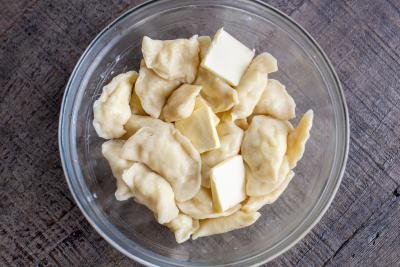

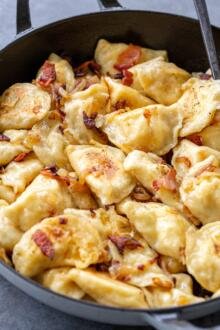
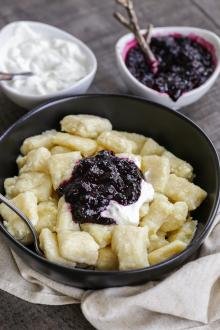
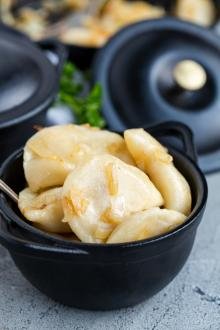

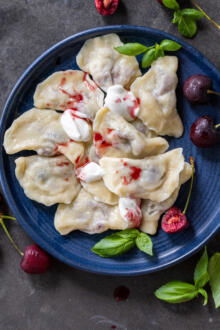
You don't use eggs for perogies dough, my Buscia taught me from a very young age how to make perogies.
I love that you learned from your Buscia—that kind of hands-on wisdom is priceless. There are so many beautiful regional and family variations when it comes to pierogi dough!
Just noticed you have two pierogi dough recipes on your website: classic and this one with the addition of lukewarm water. Which one do you prefer? What's the difference in texture?
Hey Kate, Great question! They are very similar in texture, but the pierogi with farmers cheese is a little bit thinner and sweeter than the classic one. It also has more flour, so more liquid is needed. I love both doughs, just depends on what filling I'm craving. I hope this helps!
Hi Natalya...I was wondering if you have Poltava’s Halushki Dumplings recipe….seen it on someone’s YouTube channel & cant stop thinking about it but i cant find the recipe.
Hi Daria, I have never made them but my sister studied to be a chef in Poltava so I think we are in luck. Let me ask her and see if we are able to do something about it. 🙂
Ohhh really? That is so amazing. I hope you be able to post it because I love your recipes & I print them all the time, for my binder. Thank you so much.
Is Farmer's Cheese similar to Baker's Cheese? Sounds like it may be the same. My grandmother used to use "baker's cheese" but it is hard to find these days. Can we add potato to the Farmer's Cheese to make the cheese go further? If so is there a ratio, like 50/50? Or would that not be recommended? I am looking forward to trying this recipe.
Hi Stephan, I have never heard of Bakers Cheese reference to cottage cheese. We have a link on how to make farmers cheese in the recipe, maybe see if they look similar? But.. I wouldn't combine it with potatoes, its not going to taste very good.
I use different sized drinking glasses to cut dough into rounds (dip in flour before cutting into dough) to get different sizes of perogi.
I find just a regular drinking glass is a good size, juice glass for bite-size perogi and perhaps a large coffee cup for larger ones. Wine glasses would probably also work but be careful the glass is not too thin as you will be pressing into the dough! Don't want to cut yourself or have broken glass.
Thanks for the feedback Mariana and for sharing such great tips with others!
These are sweet perogies where I make regular cheese perogies.
Dry cottage cheese, salt to taste if cheese is salt free, bit of sour cream. No need for egg but you can.
Use hand mixer and blend till smooth. Only perogies allowed to make other than dessert. Parents Ukrainian and many aunts head of Ukrainian halls in Western Canada.
Should try.
Thanks for sharing your version! We appreciate it.
The dough was WAAAAAAAAY too sticky and wet even after kneading for 10-15 min by hand. Had to add over 1 cup of extra flour to get it right in the end. The dough is also super difficult to roll even after resting and letting the gluten develop. Not happy and needless to say, not using this recipe again 🙁
I have found that I need to adjust for humidity sometimes when making perogi dough. On a very humid day, I usually need to add more flour/salt OR cut down on the liquid.
I will usually put half the amount of liquid to the amount of flour used, to start. (for example, for 2 C flour I will use 1C liquid, including egg or oil to make the 1 C).
What you can do is start with a little less than half the amount of liquid and then add a bit more flour if too sticky/wet. If I end up adding quite a bit more flour I will also sprinkle in more salt.
My test is to rub my dough-covered hands together and if the dough forms (balls) together and just comes cleanly off my hands, then the dough is the right consistency. Good luck and enjoy!
Hi Windchime, I'm sorry to hear it didn't work out for you. The dough is very soft and easy to work with, so I'm not sure what went wrong that it was so sticky. What flour did you use?
Is there a certain thickness to roll the dough out to? Tried to boil one but felt not cooked as much as it should be taking it out once floating??
The Babas used to say that the dough should be thin enough to read a newspaper through! That might be a bit too thin if you haven't made them all your life - you don't want the dough to tear because it is too thin. I roll my dough (which should be elastic) to about 1/8" thick. that's thin enough to handle without tearing. I don't like too thick a dough as it's all about the filling! Practice 🙂
Hi Gina, you can let them simmer for a bit more when they are on top. But I typically roll it our to about 1/12 of an inch or about 3mm. Hope this is helpful. Enjoy
Best perogis ever. I use ricotta cheese and no sugar and they taste exactly like babcias, love the dough's texture, it REALLY brings me back
Thank you!!!
Hi Pat, ah I'm so glad you found a recipe that reminds you of your grandmother! I love nostalgic recipes 😀 Thank you for giving this pierogi recipe a try!
I am looking forward to trying your recipe. I have my mother's which is a little different. I make these for Christmas and like to make ahead and freeze. Do you recommend freezing before or after putting in boiling water.
If you freeze cooked perogi you end up with a big goopy mess that's stuck together.
Line a cookie sheet with parchment paper and/or sprinkle with flour to prevent sticking. Tray freeze. I give the tray of frozen perogi a short rap on the counter or drop it onto the counter from an inch or so above to loosen perogi, if need be. Once frozen, you can fill ziplock bags and the periogi won't stick together. You can remove individual periogi from the bag to cook as many as you need at a time. I bring the water to a boil, gently slip the perogi off my fingers into the boiling water. Use a wooden or plastic utensil to stir the water in a circle (so you don't cut into the perogi) until water comes back to a boil.
For frozen perogi, I turn the heat down to a gentle boil or simmer and leave them in 1-2 minutes longer to make sure filling is heated/cooked thorugh. If you continue on to pan fry then just remove them when they float to the top. You should coat perogi with EVOO or butter (heart patient) in a bowl right after they come out of the boiling water to prevent sticking.
When you have a large roasting pan of them for the holidays/gatherings, and they've been sitting for a while, take a kitchen towel. clasp the lid down against the pan and give one (or two at the most) quick firm shake. This will un-stick them again. Too many shakes or too hard of a shake will tear them apart.
Hi Chris, I typically freeze them before boiling, this prevents them from sticking together. I would recommend reading "Freezing Pierogi" section in the post. We share the details on freezing them. Enjoy
When I was growing up we always went out for Pierogi dinner and they were much larger and deep fried. How would you make the larger ones and is there a tool you can buy to make the larger ones? Thanks I want to try this soon as I don't care for the potato ones. I was brought up on the farmers cheese.
Hi Michelle, I am wondering if you are referring to these. https://momsdish.com/recipe/6… I hope this is what you were looking for.
They took time to make it work. I put a lot more flour and rolled cut the circles and individually took each circle before filling and filled in my hand because they stuck the first time on the board. Anyways they did turn out amazingly delicious after some tries. Thank you!
Hi Angelina, I am so glad it worked out in the end. Thank you for taking the time to leave feedback. Enjoy!
I learned to make them from my mother in law. I do not do sugar and we serve them with a rich cream gravy and pork chops. This is recipe that you need to make several times and maybe have some guidance to get them right. Once you do, they are worth the labor to make.
Hi Natasha, That sounds so delicious!! Thank you for sharing this!
My first time ever and what a disaster. Dough too thick, way too much cheese leftover. How thick do you roll out??? Missing my mom. My fault I never made them with her or my babcia. I think a first timer needs to do it with someone experienced. I only got 18 pierogis. Well see how they taste on Christmas Eve. Good thing my sister got store bought as a backup. Drying my tears!! Lol
Not recipe's fault.
Hey there! I am so sorry to hear that! I am sure you did a wonderful job, I am wondering if the dough was a little off. I hope you give this recipe another go in the future. It's so great to have these traditional recipes under your belt.
Perfect vareniki dough! So easy to work with.
I am delighted to hear you love this recipe, Lana! Thank you for your feedback. Happy holidays!
Can you also share a pieroshki recipe?
Hi Del- which kind are you looking for exactly? We have several on the blog! This link will take you to the piroshki recipes we have. Enjoy! https://momsdish.com/?s=piros…
Hi! I am wondering if I need to boil the perogies... Can I freeze and then pan fry with butter. Or must these be boiled
Hey Terra- yes, it is recommended you boil them since the dough is raw. Pan frying would take a lot longer and I haven't tried it before with these. If you want that pan fried taste, you can always do that after boiling them! Enjoy!
The dough was beyond sticky after kneading for a long time which made the process beyond frustrating. Next time I am craving these Ill just go to the speciality market. Bummed I spent all this time and am not happy with the final product.
Hey Michelle- I'm so sorry to hear that, I know how frustrating that must feel. In the future, if the dough is still sticky I would recommend you keep adding extra flour a little bit at a time until it's the perfect consistency. Sometimes the flour type can make a difference, as well as how it's measured.. so I recommend adding more if needed to make the dough soft and work-able. If you give them another try I hope you love them!
Absolutely agree with you! I'm a cook by a profession. Measurements depend on the flour grade and quality. I personally prefer canadian flour. Simple solution, keep on adding extra flour little by little untill you get that desirable consistancy.
Thank you, Natalie! I like Canadian flour as well.
I love pierogi with farmers cheese, but I don't think my mom added sugar. This may be a silly question, but can I just use this recipe sans cheese and get good results?
Hi Terry - Thanks for the question. Technically, you can add whatever filling you'd like to pierogi. If you skip the cheese filling, you can fill them with fruit, poppy seed filling, or whatever else you'd like. Hope this helps!
Hi. This may seem like a dumb question. When you say to use a cup to cut the dough into circles, can you give me the size of the cup please (width). I have tried to make Pierogi's but they are always to small and not enough filling. Thank You.
We use a Tuna can to cut the dough. It's the perfect size.
That's so clever! Thanks for sharing, Elizabeth.
Hello, Diane. I'd say roughly 3 inches in diameter. If this still seems too small, you can always use a wider cup and just add more filling! You will have less pierogi overall, but they'll be bigger. Enjoy!
Natasha! Yesterday I left a review on potatoe pirogues. Last night I made farmers cheese and made these вареники today. Recipe came out perfect, easy to work with, superior results. The only change I made was omit the sugar in the dough. It was perfect. My Dad's face lit up when I put these on the table. He loved it!!!!
Your comment made me smile. I'm happy you all enjoyed them. Thank you for sharing, Lena!
Hi Natalya, I used to always make veraniki with my grandmother and mother, but I haven’t made them in years. My cousin is coming to visit and wants to make them with me. I lost my precious recipe, and am going to use yours.
I have a tendency to over knead dough by hand, then it gets tough, and the last time I made pasta dough in my Kitchen aide I had to keep adding flour and it was tough:( Which do you recommend, and any tips? Thank you, Cindy
Hey Cindy, this dough is very soft and easy to work with. I think adding too much flour could me it tough. Instead of adding more flour to the dough, I would flour the surface generously.
I hope you love the outcome! Enjoy time with family!
I used Canadian flour but had to add 5th cup of flour it was so sticky, is the description correct or right?
Hey Inna, if you knead the dough and allow it to rest, it should be more elastic. Flour the working surface as well, it should work well. If you see that it’s still sticky, you can add more flour. Enjoy
I just read your article and have to say that my family never
puts sugar in the farmers cheese/dry cottage cheese. This would make it sweet more like a desert. This is not used as part of a main meal only desert.
I'm from a large Ukrainian family with several aunts in charge of the kitchen at Ukrainian halls and we have never done this.
We will add a tsp salt and some sour cream and possibly a egg yolk for the cheese filling.
As for your dough it is basic for beginners but for advanced cooks the dough is so soft similar to gnocchi.
As for eggs in the dough it doesn't make the dough softer, quite the opposite, so you have to watch the quantity of eggs to flour. Instead of milk use oil.
Your whole recipe is for desert perogies. We never put sugar in our dough.
I grew up in a Ukrainian family and my mother and grandmother also never added sugar. I ordered it this way once in a restaurant and couldn't stand it. So I think, traditionally it is best without the sugar. I'm not sure if you can like both the sweet and non- sweet versions as they are so different. Mom used to use half farmers' cheese/half cottage cheese and then added a dollop of sourcream on top at the table. Yes, it was served as our main entree not an appetizer.
Everyone's version is a bit different, we love this version as a dessert or brunch option.
Yes, sounds like our family has a different recipe. This is our favorite recipe for breakfast or brunch. Hope you give it a try, it's so good!
Hi Natalya! I am eager to try this recipe! I traveled once to Poland and a lady shared her dough recipe with me. I never took down the ingredients, but I do remember the addition of sour cream, to the flour, water and salt. I don't recall the eggs in the ingredients. I have searched a variety of recipes and many of them have just a basic flour, water and salt. What might the addition of sour cream/kefir, and eggs add to the dough? How will the dough be different? I would love to hear your insight. Thank you!
Hi Liliana, eggs are used for color, bring ingredients together and make the dough tender. We have tried several recipes and this one has always been a favorite.
I moved to Utah from Chicago many years ago, and have struggled every Christmas to find the pierogis of my childhood. Mom used to buy them from numerous Polish shops around the city, but never made them herself. This year I decided it was time
to bring back the tradition and I hunted for a recipe online. These pierogis not only reminded my family of our childhood Wigilia, but also tasted even better! Thank you for allowing us to continue the pierogi tradition! I'll be keeping this in my recipe box for years to come!
Dorian, I am so happy to hear this. This is why I love what I do. Thank you for sharing your story, it gives me extra motivation. 🙂
Would like to make a non-sweet version of farmer's cheese pierogies. What do you suggest?
Hey Eva, you can remove sugar and add a bit more salt. I don't know what other seasonings would be good with salty vareniki.
Please what is farmers cheese and. European butter
farmers cheese is dry cottage cheese. For non desert perogies you put approx 1tsp per 1 lbs cheese, add some sour cream to smooth and possibly 1 egg yolk.
the amount of sour cram depends on how dry the cottage cheese is.
Thanks for all the tips!
Here is the link to farmers cheese: https://momsdish.com/recipe/2…. Lots of stores sell European butter, you can google for a few brands.
Can I make the dough a day ahead?
Hey Jane, you can, just keep it in a sealed container.
HI Natalya! I love your site!! You have wonderful recipes. I was bothered however reading your history on the name difference between Varenyky and Perogies where you said in Ukraine they are referred to as Perogies which is not at all correct. They are called Varenyky, ( варити - Varite, meaning boil) and a variety that is baked is called Pyrohy. The term perogy became a common identifiable name in north America because of the large number of Polish companies who branded pre-made varieties and made them mainstream.
I am a Ukrainian English and my recipes have been handed down directly from grandparents of the Ukraine 🇺🇦 and vereniki is all I know it’s potato cheese filled fried with onions
I’m not saying anything is wrong with anyone else’s history just want to share mine xxx
Hi John, thank you for sharing your feedback. There are a lot of versions of Ukrainian Vareniki. Yours sound more modern because cheese wasn’t available in Ukraine back in the days. Unless it was farmers cheese. I do like the potato and cheese combo! 🙂
Once again your all to young to know. As farmers in the Ukraine we had farmers cheese/dry cottage cheese. This is the same in Western Canada.
Some people find the sharpness of just cheese to much and like to mix with potato and onions which I do for my husband but he's not Ukrainian.
Remember to make the really great dough and use cheese is more expensive so it's cheaper for commercial enterprises to skimp.
Mariane, not sure if age plays a role. I grew up on the farm in Ukraine and we made our own farmers cheese. The style of American cottage cheese and farmers cheese would be different. It wouldn't work well for this recipe. I would suggest making or purchasing farmers cheese. Homemade farmers cheese doesn't really have sharpness unless you are using cheddar cheese.
Hey Nina, thank you for sharing your feedback about the recipe. I think it will be useful for others.